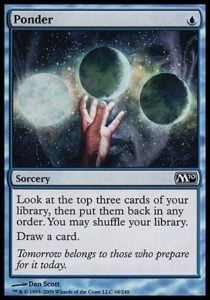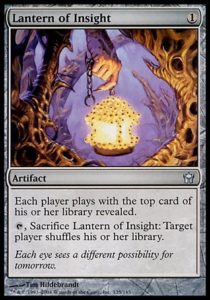Many articles have been written on how to play various decks: on sideboarding, on lines of play, on card choices for a deck or archetype. However, there are far fewer articles that focus on how to go about choosing which deck to play for a given format or event, yet it is a choice that I believe is equally (or more) important. In fact, whenever a player drops from an event with an unsatisfactory record, you can often hear them chalking it up to poor deck choice, or misreading a metagame. And as I prepare for a few upcoming Constructed tournaments of my own, I wanted to outline a few of the most prominent deck selection pitfalls to ensure that I (and maybe you, too) can avoid them.
Disregarding the Best Deck
There are a variety of reasons to avoid playing the “best deck” in the format. Maybe you think you wouldn’t be favored against those who have been playing the deck longer, or you think the deck has too large of a target on it’s back, or you think you can gain an edge from playing an unknown quantity. While any of the above may be true, you should never dismiss the best deck as an option for your upcoming tournament without at least putting in a few reps to understand how it functions and try to gain an edge against it. If, after your testing, the deck you’ve been jamming against the best deck still doesn’t feel favored, maybe it’s time to bite the bullet and sleeve up that dominating list instead of trying to beat it.
Sticking with Your Deck of Choice
This can be a double-edged sword. You know the interactions inside and out, when to keep and when to mulligan…but recognizing when your deck isn’t well positioned, especially in non-rotating formats like Modern and Legacy, is an equally valuable skill. A good rule of thumb that I use is to look at a format’s metagame broken down by deck percentages (MTG Goldfish is a great resource), then analyze your deck’s match-up against the five to seven most popular decks. Your deck should be favored against over 50% of those decks; if it isn’t, it may be time to try something new.
Altering a Winning List
This amazing new brew Top 8’s a Grand Prix, and you can’t wait to get your hands on it. But you don’t think these cards should be in the maindeck, and you don’t understand why that card is being run in the sideboard. You immediately make changes to better suit your style, but then the deck doesn’t perform.
This is something I often see when a new archetype breaks onto the scene or when someone picks up a deck for the first time. It’s important to remember that the player who did well with that deck chose those cards for a reason. Testing the deck against the other popular decks in the format, unedited, is an important first step to understanding the role that each card plays. If possible, consult a sideboard guide. Discuss the card choices with others looking to play the deck. But only start making changes once you understand what each card does within the context of the deck.
Disregarding the Metagame
This can be tied to playing the same deck that you’ve always played. It’s also an incredibly easy-to-overlook mistake when formats shift so quickly from week to week, or even from day to day. I’ve found this to be especially true for Magic Online tournaments, where you don’t have the burden of tracking down and sleeving up physical cards. Tournament results on a Saturday can cause the metagame to shift so that competitors on Sunday are prepared for the top performers from the previous day. In paper, it moves a bit slower than that, but seeing people like Corey Baumeister and Brad Nelson Top 8 Grand Prix with four different Standard decks over four nearly consecutive weekends is a huge affirmation that the metagame is a living, breathing thing that requires players to constantly shift to combat it.
Keeping an eye on the most recent tournament results and how that could affect the upcoming tournament is an important step in understanding what to prepare for. Are other players trying to beat the best-performing deck? Does it matter? Keep an eye on top-tiers decks and always consider which cards you could add to your maindeck and sideboard to attack the meta.
Ignoring Your Strengths
While this may fly in the face of some of my previous points, I think knowing yourself is just as important as knowing the metagame, if not more important. While it’s crucial to understand match-ups against dominant decks, if a deck like Lantern Control in Modern seems to be the best-positioned deck and I know that it isn’t my style, I won’t pick it up for my next tournament. Instead, I would consider decks have good Lantern match-ups that are within my wheelhouse and evaluate how well-positioned they are against the rest of the field. Keep in mind that, if you’ve never played the deck before, you’ll want to make time to learn it, too.
That brings me to my final point…
Audibling to a New Deck
There’s a tricky balancing act between picking the deck you think will be well-suited for a metagame and giving yourself enough time to learn the ins and outs of that deck. My rule of thumb is to choose a deck about a month before the tournament I’m preparing for. This gives me ample time to learn the deck’s match-ups and tweak the maindeck and sideboard to account for my playstyle and the expected metagame. However, this number is different for everyone: most pros can pick up a new deck for tournament after tournament, whereas some friends of mine will only pick up a new deck once every three or so months, or longer. Knowing the speed at which you learn new decks and card interactions will help you plan more effectively for your upcoming events.
Picking the right deck at the right time is one of the biggest challenges competitive Magic players face. Sometimes it feels like trying to predict what will give you an edge against the majority of people playing at your next big tournament is like throwing darts at a spinning board. However, I believe that with the right combination of preparation, knowledge of the format, and knowledge of your own skills (and of course a little bit of luck), you can arm yourself with the right tools to prepare for any constructed tournament. You won’t always get it right, but you can always learn from the experience and keep improving.

A Spike at heart, Chantelle spends her free time prepping for tournaments, working toward the ever-elusive Mythic Championship, and championing other competitive ladies. She’s a combo aficionado and seasoned aggro deck player, and Standard and Modern are her preferred formats. Growing and improving as a player, both technically and in her mental game, are of the utmost importance to her.



